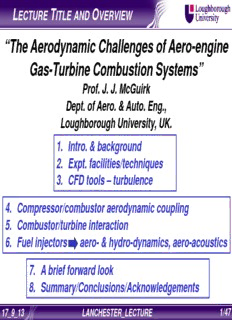
The Aerodynamic Challenges of Aero-engine Gas-Turbine PDF
Preview The Aerodynamic Challenges of Aero-engine Gas-Turbine
L T O ECTURE ITLE AND VERVIEW “The Aerodynamic Challenges of Aero-engine Gas-Turbine Combustion Systems” Prof. J. J. McGuirk Dept. of Aero. & Auto. Eng., Loughborough University, UK. 1. Intro. & background 2. Expt. facilities/techniques 3. CFD tools – turbulence 4. Compressor/combustor aerodynamic coupling 5. Combustor/turbine interaction 6. Fuel injectors – aero- & hydro-dynamics, aero-acoustics 7. A brief forward look 8. Summary/Conclusions/Acknowledgements 17_9_13 LANCHESTER_LECTURE 1/47 A - ERO ENGINE COMBUSTION SYSTEM RR Trent 700 Combustor A330 engine 1st of Trent family EIS: 1995 57% market share 1000 units sold (Nov. 2012) RR website: “lowest lifecycle fuel burn, lowest emissions and lowest noise levels of any A330 engine” The combustor accounts for ~1% of engine cost & weight. 17_9_13 LANCHESTER_LECTURE 2/47 C OMBUSTOR DESIGN REQUIREMENTS High combustion efficiency (>99.5%) – complete fuel burn to liberate all chemical energy as heat (high and low power) Good combustion stability - combustor operates over a wide range of AFR’s Ease of ignition - both on ground and high altitude re-light Low total pressure loss – maximise overall efficiency Clean exhaust – Emissions must meet future regulations (CO, UHCs, NO , smoke) x Good temperature traverse quality – overall and radial - to ensure max. performance and turbine life Thermal and mechanical integrity – high combustor life, influences wall cooling, thermo-acoustic properties Low weight/cost Aerodynamics - mixing, cooling, atomisation, acoustic processes 17_9_13 LANCHESTER_LECTURE 3/47 R B C S ICH URN OMBUSTOR TYLE Lean dilution zone, hot enough for no Pre-diffuser - smoke + extra air for traverse control dump diffuser design RQL idea Rich burn primary zone. Rapid dilution/mixing to stable down to low power minimise stoichiometric zones 17_9_13 LANCHESTER_LECTURE 4/47 E NVIRONMENTAL IMPACT ACARE TARGETS Reducing environmental impact 17_9_13 LANCHESTER_LECTURE 5/47 L - T EAN BURN ECHNOLOGY Large multi-stream swirlers Staged, separate, rich pilot (for low power, stability) and lean main (for low No ) x 15% 40% 70% 20% 15% 40% 17_9_13 LANCHESTER_LECTURE 6/47 L – T - EAN BURN HERMO ACOUSTICS Heat release from flame can couple with combustion system acoustics All flames (but particularly Lean Burn) are prone to this 1. Unsteady heat release causes acoustic wave propagation 2. Pressure drop across injector fluctuates 3. Fluctuations in AFR of mixture reaching flame 4. (Possible) reinforcement of unsteady heat release Unsteady Heat Release Air and fuel Pressure mass flow oscillations oscillations Aerodynamic and aero-acoustic properties of injector and cooling flows crucial 17_9_13 LANCHESTER_LECTURE 7/47 E - 1 XPERIMENTAL FACILITIES Single or simplified flow elements 17_9_13 LANCHESTER_LECTURE 8/47 E - 2 XPERIMENTAL FACILITIES Single sector or multi-sector (airflow/liquid flow) 17_9_13 LANCHESTER_LECTURE 9/47 E - 3 XPERIMENTAL FACILITIES Fully annular + compressor (airflow) 17_9_13 LANCHESTER_LECTURE 10/47
Description: